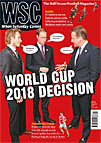 Gavin Willacy tells the turbulent tale of USA team the San Jose Earthquakes, the club that refuses to go away
Gavin Willacy tells the turbulent tale of USA team the San Jose Earthquakes, the club that refuses to go away
While British media coverage of the MLS play-offs started and ended with David Beckham and LA Galaxy’s exit at the penultimate stage to Dallas, a more interesting story was ignored in the other semi-final. San Jose Earthquakes came from mid-table to within one win of the MLS Cup final, losing 1-0 to Colorado in only their third season since returning to the league. The Earthquakes – football’s ultimate boomerang club – are back, again.
Middle-aged British fans may think that San Jose Earthquakes have been around for years – and they would be right. One of the NASL’s expansion franchises in 1974, they hung in there until the NASL’s bitter end ten years later, albeit eventually changing their name to Golden Bay in an attempt to attract more fans from the neighbouring cities of San Francisco and Oakland.
Throughout their NASL life, the Quakes played at the San Jose State University’s Spartan Stadium and despite going through several ethnic phases (Yugoslav, American, British), having far more wretched seasons than winning ones and attracting few star names, they retained a core fanbase of some 15,000. George Best found his two seasons for San Jose a stroll: he scored what is considered by many YouTube viewers to be the greatest goal of all time while playing for the Quakes against Fort Lauderdale. Other notable names to spend their summers toiling in the Bay Area were Jimmy Johnstone, Alan Birchenall, Phil Parkes, Guus Hiddink and Vince Hilaire. But in October 1984, Godfrey Ingram, once a teenage star with Luton Town, scored the Quakes’ final NASL goal – the winner against the Cosmos as 7,500 rattled around Giants Stadium.
Owner Peter Bridgwater would not let the Quakes die, however, and entered a side in the Western Soccer League before they slipped away quietly in 1989. Enter local lawyer Dan van Voorhis, who filled the void at Spartan Stadium with San Francisco Bay Blackhawks.
Van Voorhis won the bid for the inaugural MLS franchise in San Jose and the opening night of MLS at Spartan in 1996 featured a group of ex-Blackhawks players managed by former Blackhawks coach and Quakes player Laurie Calloway, but known as San Jose Clash. And when Eric Wynalda – who also had previous with the Blackhawks, – scored the league’s first ever goal, he did so wearing a ghastly jade, gold, white, red and black kit. The first impression the world got of MLS was a technicolour nightmare.
The Kraft family soon bought the San Jose franchise from MLS, employed Alan Green’s brother-in-law (Brian Quinn) as coach, delayed the retirement of Richard Gough and launched the career of Eddie Lewis. The Krafts realised the folly of the Clash name and in 2000 rebranded the team the Earthquakes. The new Quakes II, wearing light blue and black rather than the red and white of the 1970s and 80s, subsequently reached MLS Cups in three seasons thanks in no small part to Landon Donovan. But weeks after the second triumph, their latest owners – Anschutz Entertainment Group – set up a move to Texas, where they now play at Houston Dynamo, although MLS retained the rights to the Earthquakes name, logo and playing record.
Strangely, their saviour was the Oakland A’s baseball club. Taking a key but low profile role was Billy Beane, the A’s groundbreaking general manager. Soon to be played by Brad Pitt in the film Moneyball, Beane is a football fanatic with close ties to Tottenham Hotspur, who counts Aidy Bothroyd and Alan Curbishley among his thousands of fans. He leant his expertise and research resources to aid the Quakes rebirth as A’s owner Lew Wolff bought the Quakes brand – complete with history and latent fanbase – from MLS. In 2008, they came back as if nothing had happened, with the same blue and black colours, logo and coach, Frank Yallop.
The main difference was a change of home. Despite crowds holding up there throughout the turmoil, Spartan’s basic facilities were unsuitable for major league sport. The Quakes III were launched from the Oakland Coliseum, the A’s gargantuan concrete doughnut, but they now play at humble Buck Shaw Stadium, a small college ground.
In November Wolff said that he is pursuing planning permission for a new $60 million (£39m) stadium near the city airport and hopes it will be built by 2013 at the latest. He plans for just 15,000 seats – seeing Toronto’s 20,000 seats filled and rocking every game has made other MLS team owners realise a packed house is preferable to a big one.
The Earthquakes have started a trend for NASL retro resurrections. Seattle Sounders returned last year, while Portland Timbers and Vancouver Whitecaps are joining them in 2011. Maybe MLS is finally realising that however many times you try to kill them off, some clubs just won’t go away.
From WSC 287 January 2011